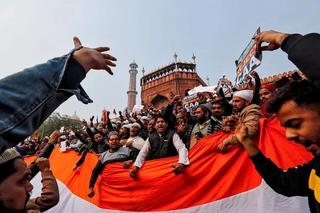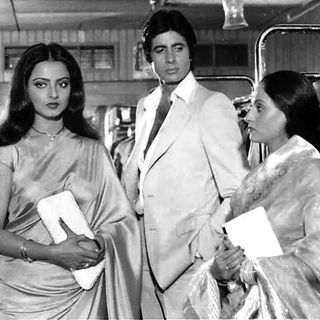
Stop Judging People’s Motives for Protesting
In trying times like these, a collective show of strength is all that matters.

On Dec. 19, Farhan Akhtar was amongst Mumbai’s anti-CAA-NRC protests at August Kranti Maidan, amongst the few Bollywood personalities who deigned to make an appearance. The National Register for Citizens (NRC) currently requires Assam’s residents and eventually the entire country, to prove that either they or their ancestors were within India before March 24, 1971, in order to remain Indian citizens; the Citizenship Amendment Act (CAA), on the other hand, allows eligibility for Indian citizenship to migrants from Afghanistan, Pakistan and Bangladesh-minority religious groups like Hindus, Silks Christians, Jains, and Parsis, but not Muslims. In effect, Indian Muslims who are unable to provide the necessary documentation to make it to the NRC will be ineligible to apply for citizenship via the CAA — rendering them as illegal immigrants.
However, when the press pressed Akhtar for his views regarding the legislations he was taking a stand against, Akhtar verbally ran around in circles, using vague statements like,“…why would so many people be upset if the act was fine?” Naturally, social platforms and right-wing media had a field day, calling Akhtar and his fumbling everything from clueless, meme-worthy to straight-up ‘legislative ignorance masquerading as fashionability‘.
Coming out on the streets to protest comes with the implicit expectation of a somber, revolutionary, knowledgable performance of dissent. An influencer taking photos at a protest, a young person making memes, or a fumbling celebrity, would inspire irritation and outrage, as the immediate interpretation of such an act is naked self-gain in a space that is meant to be altruistic. While this is an entirely fair assessment, there is also a leeway to be made for our understanding of altruism, perfection, and dissent. If the true measure of a protest is its reach, its numbers, its ability to sway the people and the change it effects, then frivolity may have a bigger part to play than mere disappointment.
In the history of dissent, there has never been an ideal way to rally for the right thing. Journalist Mary McGregory called the 1971 May Day anti-Vietnam war bridge blockades in Washington D.C “the worst planned, worst executed, most slovenly, strident and obnoxious peace action ever committed,” because elaborately detailed tactical manuals regarding the blockades were distributed amongst people, which were also easily accessible by the U.S Government, who then brought in the police, the military, and the national guard to arrest more than 7,000 non-violent protesters. Occupy Wall Street, a protest movement against financial inequality, was often criticized for a lack of clear goals. The 2017 U.S Women’s March, borne out of the election of virulent misogynist Donald Trump as the President of the U.S, has also been criticized for both its lack of goals and its lack of intersectionality.
No matter how ineffectual these movements seemed because of the critique levied against them, they did push for a slow domino effect towards change — whether it be class inequality, women’s right to political representation, or even just the act of drawing an unaware government’s attention towards the might of its citizens. Large scale community action, especially the current nationwide protest movement in its nascent stages still, does not have any space to sit and interrogate the individual intent and altruism of each protester who shows up, because there is a point to be made. No matter how much of a weak link a protester’s individual intent may seem up close, it doesn’t matter beyond the intention’s ability to get bodies on to the ground.
Related on The Swaddle:
The Mumbai Women Protesting Against CAA and NRC, in Photos
Individuals, as a rule of thumb, are neither pure nor smart in hyper extremes. Altruism, though significantly high amidst human beings in situations of panic, sorrow, and disasters, will never be the sole reason an individual chooses dissent. According to trauma therapist and psychologist Ruchita Chandrashekar, a variety of contextually individualist reasons influence a person’s headspace and push them to protest, including personal guilt, personal heroism, the need to experience rage-induced catharsis, the need to experience a community of like-minded individuals, collective joy or sorrow.
“In situations like these, you either go towards apathy or helplessness. However, apathy is not activation, but [protesting] is. It gives you a sense of solidarity, a way to assert yourself, and lets you experience power in the face of powerlessness,” she said. These reasons still push people out of their homes to arrive at protests and march along with those who may have a better moral claim to dissent and that’s all the value there is to them. To fill a ground, a road, to obstruct, and to be heard by those who oppress.
According to ‘The Concept of Social Movement’, a paper by sociologist Mario Diani, social movements like protests are informal interactions between multiple individuals, groups and organizations engaged in conflicts (political/social) on the basis of shared cultural identities. In ‘Bringing The Crowd Back In: The Non-Organizational Elements of Social Movements’, sociologist Pamela. E. Oliver writes “real social movements are complex mixtures of ideological pronouncements by leaders, diverse actions undertaken by crowds and organizations, and shifts in the consciousness and daily actions of people.” However, the demonstrations against the CAA-NRC are more a crowd of vastly diverse faces pulled together — an expressive crowd, where individuals see the protest as both means to an end and the end goal. In expressive crowds, as sociologist Erich Goode writes in his book Collective Behavior, protesters participate in rallies to both drive across a point and to feel solidarity.
Oliver also writes, “In real social movements, actions affect other actions.” Consider the more seemingly frivolous actions taken during the CAA-NRC rallies — a protest Instagram update, hilarious memes, creative protest signs, the works. These actions are performed by protesters — especially the millennial sort — to both showcase their stand against the legislation and to communicate a sense of solidarity with an ocean of diverse individuals who have the same contempt for said legislations in mind. If the greatest criticism of such actions is that they dilute the seriousness of a movement, the greatest gift of such frivolity in the face of serious turmoil is attention. In order to rally together and make an attempt to influence repealing of both the CAA and the NRC, information diluted and spread across frivolous channels like social media make for quicker parsing of said information, which makes for stronger emotional reactions to said information and so, greater need to go out and join the demonstrations set up. Taking a selfie during a protest may seem facetious and in bad taste, but it also communicates that the protester would rather be here standing up for the rights of their fellow citizens than anywhere else, which is a strong showcase of intent and a potential influence for someone unaware of the nation’s turmoil. If a selfie gets another body on the right side, does it truly matter if it dilutes anything at all?
Related on The Swaddle:
Mumbai’s #SupremeInjustice Protest Against SC’s CJI Decision: Photos
The rapid spread of information regarding acts as polarizing and vicious as the NRC-CAA is what is enabling youth to take to the streets, and the rapid spread of the subsequent acts of violence against students is also ensuring greater eyeballs and turnout. This was enough even to influence Farhan Akhtar to brave the ire of his spineless industry and take a stand. While it is possible that he may not understand the legalese of the legislations he is protesting against, he knows enough to know that something is deeply wrong. Wanting to stand up for fellow citizens who are suffering and will suffer more is reason enough to show up and protest. Plus, this then influences scores of individuals who decide to grasp a surface level understanding of what is happening around them.
While India’s right-leaning community doubles down on documenting and critiquing how ‘clueless‘ and misinformed young protesters are, it is imperative that we do not fall for the need to gatekeep each other due to this. There is no ‘ideal’ protester with the right, ideal politics and all the correct answers, there are only scores of individuals trying to comprehend the horrors that their nation is primed to inflict on the powerless.
It does remain necessary to give and accept criticism, to hold one’s own within a debate, to understand what one is protesting. But nothing remains more important than allowing people the right to understand, experience and empathize with the raw sense of wrongness and disgust spilling over at the rallies denouncing the NRC-CAA, and nothing remains more important than taking to the streets to exercise your right as a citizen to protest what is undemocratic.
Aditi Murti is a culture writer at The Swaddle. Previously, she worked as a freelance journalist focused on gender and cities. Find her on social media @aditimurti.
Related


From Feminist Porn to Psychic Tears, the Best of The Swaddle in 2019
